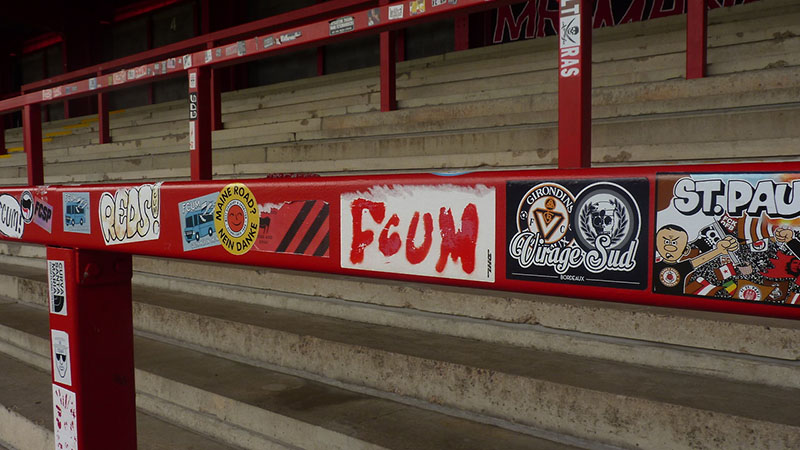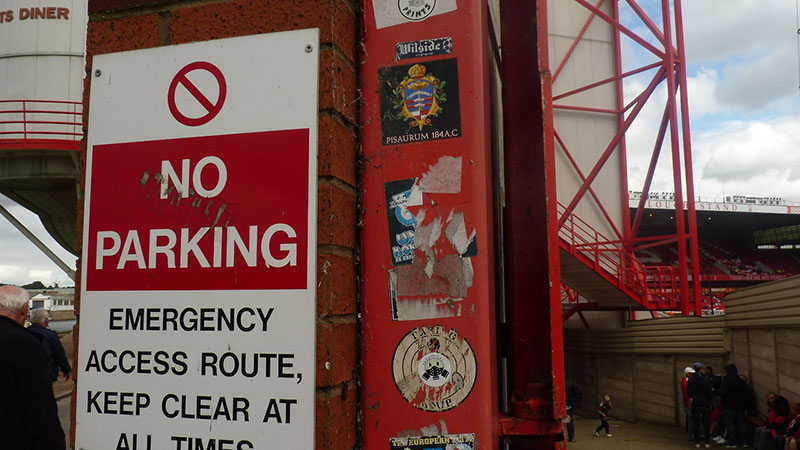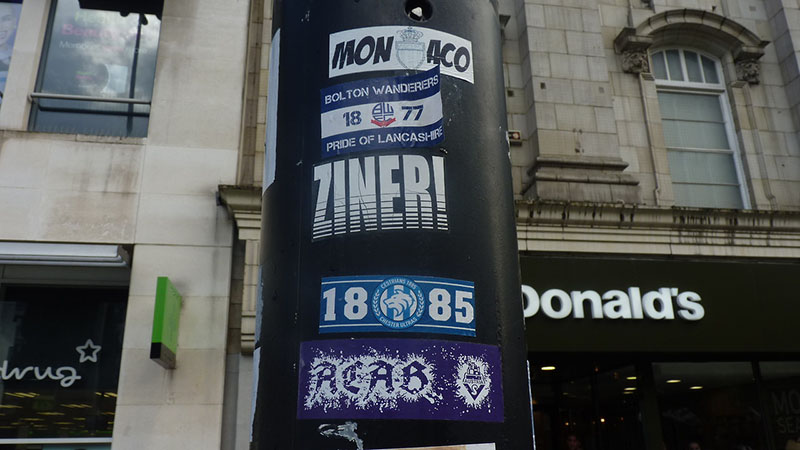
We are now accepting entries for the 2018 WSC writers’ competition. By way of inspiration, here is Matt Johnson’s runner-up entry from 2017, about a a new phenomenon of global football culture sweeping the streets
19 March ~ If I were to say “I’m fascinated by football stickers” I’m sure that most people would assume that I was talking about Panini. The enticing possibility of finally seeing Welsh internationals in Panini packets may have proved too difficult to resist during Euro 2016 but that was only a passing infatuation. My fascination lies with the kind of football stickers that fans apply to street furniture.
You may have seen the unmistakable signs: a splodge of colour on a lamppost, a forlorn piece of faded paper on a drainpipe, the remnants of adhesive on the back of a road sign. The stickers are definitely there because I’ve lost count of the clubs I’ve seen represented.
I saw my first on a bus timetable at the Cheshire Oaks Designer Outlet in 2006, referring to two Polish clubs as a “Band of Brothers”. Within a decade stickers appeared to be everywhere. A hobby with artistic pretensions came to mind so I began photographing them. I started a Tumblr site and briefly considered an aspirational biography: “Stickers on Street Furniture. Mixed Media. This continuous work takes the juxtaposition created when the radical self exists within commodified public space and projects it onto the mind of the viewer. The viewer is then forced to question 21st century assumptions.” I opted for: “The exciting world of stickers on street furniture!”
I scan as I walk so can spot the right sort of small coloured shape at 30 paces. It doesn’t matter whether I see an exquisitely designed creation or a weather-faded expression of club loyalty, they all count.
It’s funny what you see when you have the inclination to look around. I’ve seen a Preston sticker on a Munich airport sign, and ones for Doncaster Rovers on a Ljubljana drainpipe, IFK Gothenburg on a Bangor postbox and Honved outside the Colosseum. From an anthropological angle the stickers are territorial markings, from a social geography angle it’s interesting to see which fans have visited a place.

The environs of football grounds obviously feature stickers and cities are generally well laden, with London, Manchester and Glasgow offering good selections. City centres in the weeks after European matches are a particular boon. I once assumed that transport hubs would offer rich pickings but stickers seem to be removed fairly swiftly, although you may see some.
The most common stickers seem to be British, German and Polish. There must be websites that provide supplies because certain generic designs are popular at given times. At the moment it’s the Adidas stripes placed below a club badge and “[Club Name] On Tour”. The most fertile location has been Werder Bremen’s solar panel-encrusted stadium and the location with the most cosmopolitan collection was Boudicca’s corner near Big Ben.
After a few months of sticker hunting I thought I’d noticed a contrast between European artistry and mundane British bombast but mythical glamour often obscures humdrum reality. For example I assumed that there was absolutely no connection between European football aristocracy and fitted kitchens until I noticed that our kitchen sink had been manufactured by Teka, an erstwhile sponsor of Real Madrid. My interest is sustained by the thoughtful representations of fan culture. Notable examples I’ve encountered include Clapton FC’s Andy Warhol soup can pastiche in York, the stylised head of a Sampdoria ultra outside Dagenham & Redbridge’s ground, Millwall’s Only Fools and Horses-inspired logo in Manchester and Preston’s reworking of the Public Image Limited logo near Euston.
My heart swells when I see progressive politics from the likes of St Pauli, Rayo Vallecano or Livorno. I’ve seen rivalries graphically represented by the application of one sticker over another and felt intrigued by surprising connections such as Tranmere and Eindhoven.

The most bewildering example was a CSKA Moscow sticker that I saw in Manchester which featured goose-stepping legions and other fascist iconography. When you consider that CSKA were once part of a Red Army that fought a bitter war against the Nazis, and ultras generally have a fierce attachment to their club’s history, the sticker was an extremely odd paradox. I wasn’t quite so bewildered after googling “Russian fan culture”.
There are several upsides to this hobby. Another layer has been added to my interest in football. By discovering the nuances of fan culture I have discovered more about a sport I thought I knew. Take the occasion I saw a “Westphalia On Tour” sticker. I assumed that German supporters had left it but the internet informed me it belonged to Olympiakos fans.
Stickers are often removed so I regularly feel that I’m capturing the brief moment of social history that occurred when supporters visited somewhere, such as the time Borussia Mönchengladbach fans covered a Manchester bus stop with stickers or the time AIK Stockholm followers visited the pubs of Rhyl.
On a simpler level my fug of cynicism has slightly dissipated. I have taken almost as much pleasure from seeing stickers in a city centre as I ever did from the anticipation of opening fresh Panini packets. I have another reason to enjoy travelling, whether to matches or in general, as every destination is now an opportunity. I can look forward to wandering around Glasgow, Bremen or Macclesfield with a greater appreciation of our urban environment.
The hobby has also shown that you can always take something from life, no matter how inconsequential the activity. I feel that I can revel in the simple moment of standing in a different place. It doesn’t matter whether I’m surrounded by the majesty of the Cinque Terre or the lampposts of London I’m equally content. So if you’re ever walking down the street and you encounter someone who appears transfixed by a road sign please don’t judge them too harshly. Matt Johnson
Click here to find out how to enter the 2018 WSC writers’ competition – there is a £250 cash prize for the winner, whose article will be published in WSC this summer